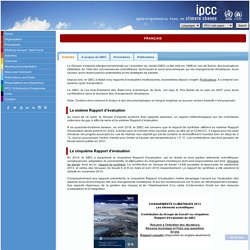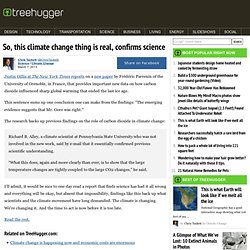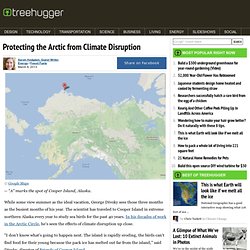

A daily record of atmospheric carbon dioxide from Scripps Institution of Oceanography at UC San Diego. Infographic explains "terrifying math of global warming" David Roberts found this cool infographic (wait, wait, hear me out) that illustrates some important info about climate change.

Like David, I feel obliged to put a little preface here about how I know what you are probably thinking when you hear someone say they have a cool infographic. Back in 2011, I wrote about how infographics were pretty much terrible and we were over using them as a format for conveying information, but sometimes, like this time, they are still great. Designed by David McCandless, this infographic, which you can see below, illustrates the amount of carbon dioxide that has been released into the atmosphere, how much can "safely" be released into the atmosphere and how much fossil fuel companies have ready to burn. It also associates the amount of global warming that will occur after different amounts of carbon release. 27 février: journée internationale de l’ours polaire.
Le plus grand des ursidés de plus en plus en danger.

Cliquer sur la photo pour agrandir C’est aujourd’hui, le 27 février, la journée internationale du plus grand carnivore terrestre, l’ours polaire (Ursus maritimus). Polar Bears International (PBI), le groupe le plus important et le plus actif voué à la protection des ours polaires, a créé cette journée afin de sensibiliser le grand public sur la situation de plus en plus critique de l’espèce, menacée principalement par la fonte de plus en plus rapide de la banquise arctique à cause du réchauffement climatique d’origine anthropique. Le groupe basé à Bozeman dans le Montana et à Winnipeg au Manitoba lance d’ailleurs une campagne appelée The Thermostat Challenge et dont le but est de sensibiliser la population sur les conséquences du réchauffement climatique sur les populations d’ours polaires.
Climatosceptiques: quand l'argent coule à flot. (Agence Science-Presse) Des journalistes et des chercheurs ont révélé l’existence d’une fondation secrète par laquelle 400 millions$ ont été versés depuis 1999 à divers groupes américains de droite, dont une bonne partie sont voués à défendre l’idée que le réchauffement climatique est un canular.

Cliquer sur la photo pour agrandir En 2010, douze de ces groupes ont reçu entre 30 et 70% de leur financement de ce fonds, Donors Trust. Parmi ces groupes, on trouve de vieilles connaissances —Heartland Institute, Competitive Enterprise Institute, etc.— c’est-à-dire des «groupes de réflexion» déjà identifiés comme des noyaux du réseau de désinformation: ils organisent des conférences, écrivent des lettres aux journaux, publient des recommandations, qui sont dès lors repris par des blogueurs et des chroniqueurs complaisants. Le flot d’argent a dépassé celui d’opposants plus visibles à une action contre le climat, comme l’industrie pétrolière ou les frères Koch, (...) par six contre un. IPCC (GIEC) Le Groupe d’experts intergouvernemental sur l’évolution du climat (GIEC) a été créé en 1988 en vue de fournir des évaluations détaillées de l’état des connaissances scientifiques, techniques et socio-économiques sur les changements climatiques, leurs causes, leurs répercussions potentielles et les stratégies de parade.

Depuis lors, le GIEC a établi cinq rapports d’évaluation multivolumes, accessibles depuis l’onglet Publications. Il a entamé son sixième cycle d’évaluation. Le GIEC et l’ex-Vice-Président des États-Unis d’Amérique, Al Gore, ont reçu le Prix Nobel de la paix en 2007 pour leurs contributions dans le domaine des changements climatiques. Note: Certains liens mènent le lecteur à des documents/pages en langue anglaise où aucune version traduite n’est proposée. Au cours de ce cycle, le Groupe d’experts produira trois rapports spéciaux, un rapport méthodologique sur les inventaires nationaux de gaz à effet de serre et le sixième Rapport d’évaluation. So, this climate change thing is real, confirms science. Justin Gillis at The New York Times reports on a new paper by Frédéric Parrenin of the University of Grenoble, in France, that provides important new data on how carbon dioxide influenced sharp global warming that ended the last ice age.

This sentence sums up one conclusion one can make from the findings: "The emerging evidence suggests that Mr. Gore was right. " The research backs up previous findings on the role of carbon dioxide in climate change: Richard B. Alley, a climate scientist at Pennsylvania State University who was not involved in the new work, said by e-mail that it essentially confirmed previous scientific understanding. Chances for slowing climate change "fading fast" Protecting the Arctic from Climate Disruption. © Google Maps -- "A" marks the spot of Cooper Island, Alaska.

While some view summer as the ideal vacation, George Divoky sees those three months as the busiest months of his year. The scientist has traveled to Cooper Island in extreme northern Alaska every year to study sea birds for the past 40 years. In his decades of work in the Arctic Circle, he's seen the effects of climate disruption up close. "I don’t know what's going to happen next.